This information describes what you can do to reduce your risk of lymphedema of the legs.
About Lymphedema
Lymphedema is swelling that can develop in your legs after your lymph nodes have been removed or injured. Lymph nodes are small, bean-shaped structures that are located throughout your body. They help move fluid out of the different areas of your body. If this fluid can’t be moved out, the tissue begins to swell.
During your surgery, the lymph nodes near your pelvis are removed to get rid of any remaining cancer. This puts you at risk for lymphedema in your legs. Your risk is also greater if you had radiation therapy or if you had lymph nodes removed from around your groin. If only your pelvic lymph nodes were removed, you have a smaller risk of developing lymphedema in your legs.
Lymphedema can develop soon after surgery or potentially years later.
Risk Factors for Developing Lymphedema in Your Legs
Risk factors for lymphedema in your legs include:
- Gaining weight or being overweight.
- Infection in the affected leg.
- Having radiation therapy to the pelvis.
- Having cancer that comes back.
- Being inactive.
- Traveling in an airplane for long periods of time.
- Constricting your leg. This happens when you have a tight ring of pressure in one area of your leg and is often caused by wearing certain clothes (such as a sock with a tight elastic).
- Exposure to extreme temperatures.
Reducing Your Risk of Lymphedema
There’s no way to know who will develop lymphedema, but there are things you can do that may lower your risk.
Protect your skin
One way to reduce your risk of getting lymphedema is to protect your skin from getting hurt or infected as much as possible. This is because the cells that fight infection go to the area where you hurt yourself and cause swelling. Your legs may not be able to drain this added fluid.
Care for cuts and scratches
- Wash the area with soap and water.
- Apply a first aid ointment to the area.
- Cover it with a clean, dry gauze or a bandage (Band-Aid®).
Care for burns
- Wrap a cold pack in a towel and apply it to the burn for 15 minutes. You can also run cold water over the burn.
- Wash the area with soap and water.
- Apply a first aid ointment to the area.
- Cover it with a clean, dry gauze or a bandage.
Watch for infections
Look out for symptoms of infection in the affected leg(s), which include:
- Redness
- Swelling
- Increased heat
- Tenderness
If you have any of these symptoms, call your healthcare provider.
Don’t wear tight clothing
Don’t wear clothing that is tight and leaves deep marks on your legs, such as socks or jogging pants with an elastic cuff. Wear loose clothing that doesn’t leave a mark on your legs.
Compression garments that are made to reduce swelling work differently. They provide even pressure and help carry fluid up the leg. You can read more about compression stockings in the “Compression stockings” section of this resource.
Avoid extreme temperatures
Extreme heat and cold may cause fluid to build up in your leg and cause swelling. Avoid or limit your time in hot tubs and saunas.
Other ways to reduce your risk
- Don’t use sharp tools for pedicures. Use cuticle-removing cream and file your nails instead of cutting them.
- Moisturize your skin often to prevent chapping and chaffing.
- Keep the area between your toes clean and dry to prevent infections.
- Don’t walk barefoot.
- Make sure your footwear fit you well to avoid blisters.
- Make sure any toe rings or ankle bracelets fit loosely.
- Try to avoid crossing your legs as much as possible.
- Wear sunscreen with an SPF of 30 or higher to protect your skin from sunburns.
- Try to maintain your ideal weight.
- Minimize your salt intake. Salt can cause swelling, which may overwhelm your lymphatic system.
Air Travel and Lymphedema
These are a few factors that may affect leg swelling when traveling by airplane.
- Cabin pressure. The cabin pressure in planes is usually a little less than the pressure on the ground. This can cause your skin to stretch and make fluid build up in your legs.
- Sitting still for long periods of time. When you don’t move for a long time, fluid may start to build up in your legs.
- Dehydration (when your body doesn’t have as much water as it needs).
Here are some travel tips that may help decrease your risk for developing lymphedema:
- Ask for a seat with enough leg room, such as bulkhead seats.
- Get help carrying, lifting, and pulling luggage that’s too heavy for you to manage comfortably.
- Get up and walk up and down the aisle of the plane, if you can.
- Do simple foot and ankle exercises while you’re sitting. Exercising throughout the flight will help with your circulation and movement of lymph fluid. You can try these exercises:
- Point your toes towards the ceiling and then back down towards the floor.
- Rotate your feet in circles and then reverse the direction.
- Wear loose clothing.
- Make sure you drink plenty of water to stay well hydrated.
- Avoid salty foods.
Recognizing Early Signs of Lymphedema
Swelling in the area near your incision (surgical cut) is normal after surgery and should go away within a few weeks.
Swelling caused by lymphedema usually begins in your lower leg(s). If it is untreated, it may move up your leg towards your torso. At first, the swelling may come and go. It may get better when you raise your leg above your chest.
Other early symptoms may include a feeling of heaviness in your leg(s) or the feeling that your clothing, socks, or shoes fit too tightly.
Treating Lymphedema
If lymphedema progresses, you can work with a lymphedema therapist to treat the condition. This treatment is called complete decongestive therapy.
The treatment includes:
- Bandaging
- Manual lymphatic drainage
- Compression stockings
- Skin care
- Exercise
Bandaging
Bandaging is covering your legs with a special, tight bandage. Not every person will need to do this. If you need bandaging, there are many ways to bandage. You and your therapist will discuss this to decide what’s best for you.
Manual lymphatic drainage
Manual lymphatic drainage (MLD) is a gentle type of massage. It moves fluid from your legs to where it can be reabsorbed by your body. MLD is done in a certain order depending on which lymph nodes were removed. Your therapist will determine what order is best for you.
Compression stockings
Compression stockings help your lymphatic system function better. Some people choose to wear them to reduce their risk of developing lymphedema. It’s important that your compression stockings fit properly. Please discuss with your physician if this option is right for you.
- Make sure the stockings don’t cause any irritation or leave marks on your skin. It’s best if your lymphedema therapist fits you with the stockings so you can be sure they fit well.
- Compression stockings come in different compression levels and lengths, including knee-highs, thigh-highs, and pantyhose.
Skin care
Keep your skin clean and moisturized. This is important for decreasing your risk for infection, and may also lower your risk of getting lymphedema.
Exercises
Gentle exercises, such as walking, are a great way to help the fluids in your body move a little better. Try to go for a walk every day, if you can.
We have listed some exercises below that will help you maintain flexibility and strength. Talk with your healthcare provider before you start doing any exercises.
If your healthcare provider approves, do these exercises once a day. Stop if you have any pain, discomfort, fatigue (feeling more tired or weak than usual), or swelling.
Here’s a video that shows you how to do these exercises and stretches.
Deep breathing
Start with deep breathing to stimulate the movement of fluid. Take no more than 3 deep breaths at a time to prevent light-headedness.
Marching in place
- Sit in a chair and place your feet flat on the floor.
- Slowly raise 1 knee without tilting or leaning backward (see Figure 1).
- Lower your leg and return your foot to the floor.
- Repeat 10 to 15 times.
- Repeat with your other leg.
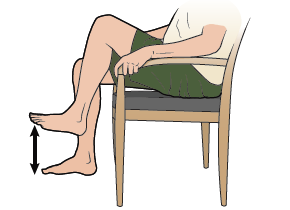
Sitting kicks
- Sit in a chair. Keep your feet flat on the floor.
- Kick 1 foot up from the floor until your leg is straight out in front of you (see Figure 2).
- Hold the position and count out loud to 5.
- Lower your foot to the floor.
- Repeat 10 to 15 times.
- Repeat with your other leg.
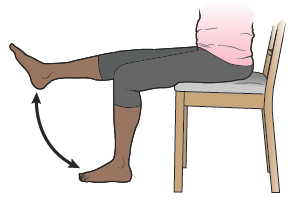
Ankle alphabets
Move your feet to spell the letters of the alphabet (see Figure 3). Go through the alphabet at least 2 times with each foot.
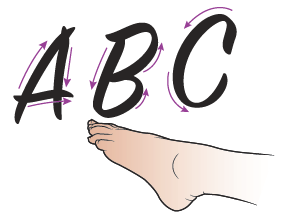
Stretches
Later in your recovery, you will be ready to do some stretching exercises. These will help to loosen the muscles in your legs and hips. When you can do these exercises will depend on the type of surgery you had. Start these stretching exercises only when your doctor tells you it’s safe.
Calf stretch
- Sit with your legs straight out in front of you.
- Loop a towel around the ball of one foot (see Figure 4).
- Gently pull the towel, keeping your knee straight.
- Hold this position for 30 seconds.
-
Repeat 5 times. Then switch legs and repeat.

Figure 4. Calf stretch
Hamstring stretch
- Sit with your legs straight out in front of you.
- Reach for your toes, keeping your knees and back straight (see Figure 5).
- Hold this position for 30 seconds.
-
Repeat 5 times.
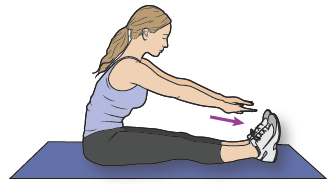
Figure 5. Hamstring stretch
Hip stretch
- Lie on your back with your knees bent.
- Cross one leg over the other and pull that leg close to your chest (see Figure 6).
- Hold this position for 30 seconds.
-
Repeat 5 times. Then switch legs and repeat the stretch.
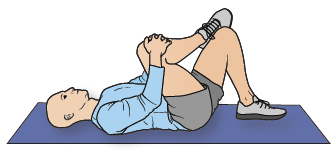
Figure 6. Hip stretch
Other Treatments for Lymphedema
There are other treatments for lymphedema available. Talk with your healthcare provider or lymphedema therapist about which are right for you.
Some other treatments include:
- Scar management. The scars left after your surgery can make it harder for your body to drain the lymphatic fluid. Scar management helps the area around your scar become softer and less tight. This will help your body drain the fluid in your legs.
- Improving posture may help the lymph fluid move more easily
- Applying therapeutic sports tape.
For more information about lymphedema, read the New York State Department of Health’s resource Understanding Lymphedema.
When to Call Your Healthcare Provider
Call your healthcare provider if you have:
- A fever of 100.4°F (38°C) or higher
- Chills
- New or unexplained pain or tenderness in your leg(s) or foot
- Increased warmth in your leg(s) surrounding a skin break
- Redness in your leg(s) or foot that doesn’t go away
- Increased swelling in your leg(s) or foot
- A feeling of heaviness in your leg(s) lasting more than 1 week
Making an Appointment
To make an appointment to see a lymphedema therapist, talk with your doctor. They’ll decide if lymphedema therapy is right for you. After your doctor makes a referral, someone will contact you to schedule an appointment. If you have any questions, call the Rehabilitation Service at 212-639-7833.
You can receive your lymphedema therapy at locations at several Memorial Sloan Kettering locations. For more information, visit www.mskcc.org/cancer-care/diagnosis-treatment/symptom-management/rehabilitation/medicine-therapy.
You can also go to the following websites to a find a lymphedema therapist in your local area:
Klose Training
www.klosetraining.com
Norton School of Lymphatic Therapy
www.nortonschool.com
Academy of Lymphatic Studies
www.acols.com
Lymphatic Association of North America
www.clt-lana.org
Resources
American Cancer Society (ACS)
Provides information about the diagnosis and treatment of lymphedema.
www.cancer.org
800-227-2345
Cancer Information Service (CIS)
Provides information about the diagnosis and treatment of lymphedema.
www.cancer.gov/aboutnci/cis
1-800-4-CANCER (800-422-6237)
National Lymphedema Network
Provides educational materials and community referrals.
www.lymphnet.org
800-541-3259 or 415-908-3681
Lymphology Association of North America
Provides educational materials and community referrals.
www.clt-lana.org
773-756-8971
Lymphatic Education and Research Network
Provides educational materials and supports research on lymphedema.
www.lymphaticnetwork.org
516-625-9675